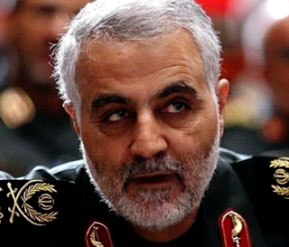BEIRUT, (Reuters) – At a meeting in Moscow in July, a top Iranian general unfurled a map of Syria to explain to his Russian hosts how a series of defeats for President Bashar al-Assad could be turned into victory – with Russia’s help.
Major General Qassem Soleimani’s visit to Moscow was the first step in planning for a Russian military intervention that has reshaped the Syrian war and forged a new Iranian-Russian alliance in support of Assad.

As Russian warplanes bomb rebels from above, the arrival of Iranian special forces for ground operations underscores several months of planning between Assad’s two most important allies, driven by panic at rapid insurgent gains.
Soleimani is the commander of the Quds Force, the elite extra-territorial special forces arm of Iran’s Revolutionary Guards, and reports directly to Iran’s Supreme Leader, Ayatollah Ali Khamenei.
Senior regional sources say he has already been overseeing ground operations against insurgents in Syria and is now at the heart of planning for the new Russian- and Iranian-backed offensive.
That expands his regional role as the battlefield commander who has also steered the fight in neighbouring Iraq by Iranian-backed Shi’ite militia against Islamic State.
His Moscow meeting outlined the deteriorating situation in Syria, where rebel advances towards the coast were posing a danger to the heartland of Assad’s Alawite sect, where Russia maintains its only Mediterranean naval base in Tartous.
“Soleimani put the map of Syria on the table. The Russians were very alarmed, and felt matters were in steep decline and that there were real dangers to the regime. The Iranians assured them there is still the possibility to reclaim the initiative,” a senior regional official said. “At that time, Soleimani played a role in assuring them that we haven’t lost all the cards.”
“SEND SOLEIMANI”
Three senior officials in the region say Soleimani’s July trip was preceded by high-level Russian-Iranian contacts that produced political agreement on the need to pump in new support for Assad as his losses accelerated.
Their accounts suggest planning for the intervention began to germinate several months earlier. It means Tehran and Moscow had been discussing ways to prop up Assad by force even as Western officials were describing what they believed was new flexibility in Moscow’s stance on his future.
Before the latest moves, Iran had aided Assad militarily by mobilising Shi’ite militias to fight alongside the Syrian army, and dispatching Iranian Revolutionary Guards Corps officers as advisors. A number of them have been killed.
Russia, an ally of Damascus since the Cold War, had supplied weapons to the Syrian army and shielded Damascus diplomatically from Western attempts to sanction Assad at the United Nations.
Their support did not prevent rebels – some of them backed by Assad’s regional foes – from reducing Assad’s control of Syria to around one fifth of its territory in a four-year-long war estimated to have killed 250,000 people.





